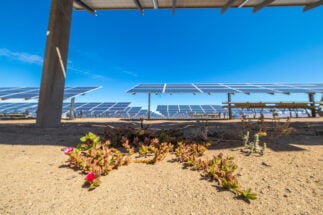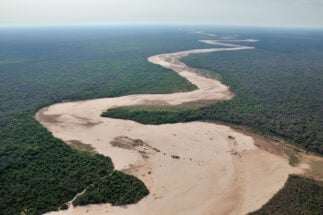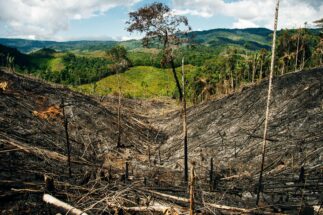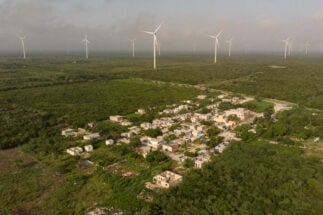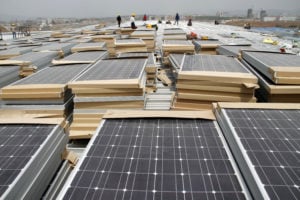Without announcing any new commitments, governments from Latin America have sought to unify their positions on climate policy two months ahead of the UN’s COP26 summit in Glasgow. At a virtual high-level event convened by Argentina this week, presidents and ministers stressed the impacts of the climate crisis on the region and called for more funding from developed countries and financial institutions to tackle it.
Representatives from Chile, Colombia, Costa Rica, Panama, Barbados, Ecuador, Paraguay, the Dominican Republic, the US and the UK, host of COP26, participated in the event. Brazil and Mexico, the region’s two main carbon emitters, were notable absentees.
Argentina’s president Alberto Fernández called for “a new development paradigm” and stronger ties between Latin American countries. This will require greater “environmental multilateralism” and a just transition that does not “cover up protectionism and widen the gaps in the planet”, in possible reference to an EU tax on goods with a high environmental footprint.
“We are called upon by the urgency of climate ambition and the need to think of innovative mechanisms to rebuild ourselves better,” said Fernández, adding; “We need environmental and social justice. That is what the development of our region has to aim for. The lessons learned from the pandemic must be applied to climate change.”
5%
Latin America's share of global greenhouse gas emissions, although this figure is set to rise
Latin America accounts for 5% of global emissions, most of which come from the energy sector, agriculture and land use change. But the proportion is rising as countries continue to develop fossil fuels. Reversing this trend will require more ambitious commitments than those already made.
The region will be one of the hardest hit by climate change, according to a recent UN report. 2020 was one of the three warmest years that Central America and the Caribbean has ever experienced, and the second warmest in South America, causing droughts, heat waves and floods.
“This event represents the multilateral spirit we need. We need to act together to overcome the impasse. Many countries in the region are showing leadership to reduce their emissions and adapt to climate change,” UN Secretary-General Antonio Guterres said at the event.
The urgency of climate finance for Latin America
The common denominator in presidents’ speeches was the need to increase funding to reduce emissions and adapt to the effects of climate change. There were also calls for sovereign debt relief as countries’ spending grew during the pandemic.
Latin America’s GDP fell by 7.7% last year and will not return to pre-pandemic levels until 2024, according to the UN Economic Commission for Latin America and the Caribbean (ECLAC). As elsewhere in the world, countries have been urged to seize the crisis as an opportunity to initiate a green recovery.
Debt-for-climate action swaps, mechanisms for payment for ecosystem services, and the concept of environmental debt are key to getting out of this crisis
However, the region appears to be backtracking. Last year, 33 countries in the region allocated US$318 billion to fiscal and stimulus measures to alleviate the economic effects of the pandemic, of which only 2.2% can be classified as ‘green’, according to a recent UN report. The figure is far less than the global average.
“Debt-for-climate action swaps, mechanisms for payment for ecosystem services, and the concept of environmental debt are key to getting out of this crisis,” said Fernández. “We need credit agencies to commit 50% of their loan portfolios to environmental action.”
Similarly, Colombian President Iván Duque called for more innovative financing tools from lending agencies and for creditors to cancel countries’ debts when they meet their climate goals. He also suggested creating a Latin American regional carbon market.
Costa Rican president Carlos Alvarado said: “We have to go into debt to face the consequences of climate change, which is increasing all the time. We are in a perverse cycle and now we have the pandemic on top of that. Climate change has major emitters and they have to do their part.”
Climate ambition
Presidents and ministers from Latin America also addressed the level of ambition in their country’s climate plans, known as nationally determined contributions (NDCs), head of COP26. Environmental organisations had hoped for more ambitious commitments but they were not forthcoming.
The 2015 Paris Agreement aims to limit global warming to below 2°C, preferably 1.5°C, by the end of this century. To achieve this, greenhouse gas emissions must peak as soon as possible and hit zero by 2050. Today, the vast majority of the region’s climate plans are not in line with these goals.
Despite Argentina’s support for fossil fuels, Fernández said the country is promoting sustainable transport and renewable energy and that it is working to eradicate illegal deforestation. Duque reaffirmed Colombia’s recent goal of a 51% emissions reduction by 2030 and spoke of the country’s efforts to reforest and boost electromobility.
“We want to see the reality of these announcements. The presidents talked about things that sound very good but in practice are not happening,” said Enrique Maurtua Konstantinidis, senior climate policy advisor at Argentina’s Fundación Ambiente y Recursos Naturales (FARN).
Emissions-free economies are technically possible in Latin America, according to a report by the Inter-American Development Bank (IDB), but requires greater electricity generation from renewable sources, electrification of industry and transport, and energy efficiency, among other areas.
The region would save up to US$621 billion annually if the energy and transport sectors achieved emissions neutrality by 2050, at the same time as generating 7.7 million new jobs, according to a report by the UN Environment Programme (UNEP).
Costa Rica remains the only country in Latin America with an official, long-term decarbonisation strategy, which includes the energy sector. Other countries from Latin America such as Chile and Argentina could present their respective plans at COP26.
María Laura Rojas, executive director of Colombian NGO Transforma echoed Latin American governments’ calls for more and better climate finance for mitigation and adaptation, and the need for unity. “The event is an important political signal about the need for Latin America to better coordinate its participation in multilateral spaces,” she said.


